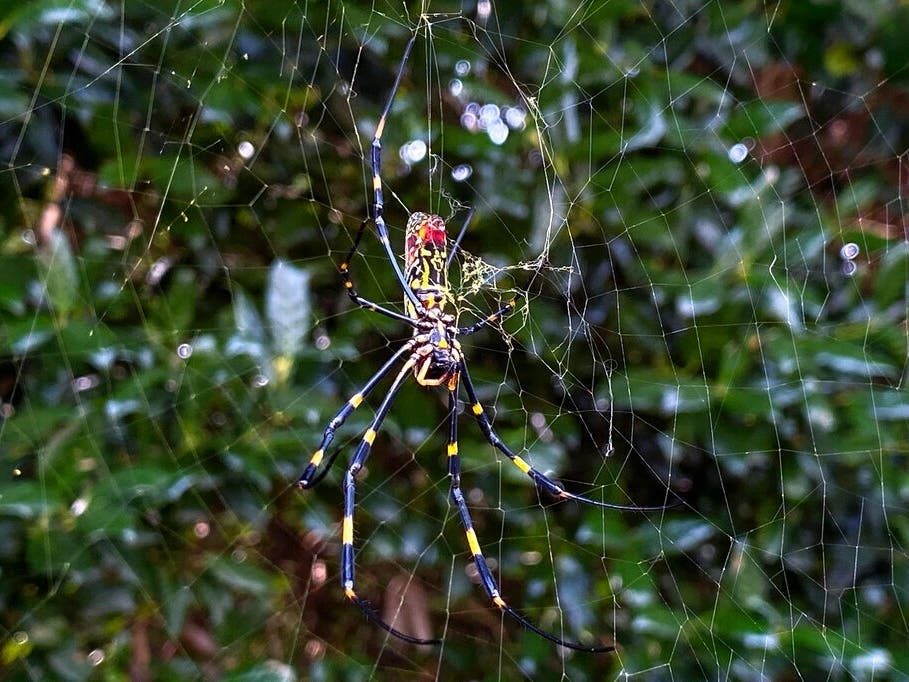Home & Garden
Will Joro Spiders Fly To New Jersey? It's Possible, But Don't Panic
Joro spiders use their web silk to ride the wind and cover distances up to 100 miles. It's possible they could survive in New Jersey.

NEW JERSEY — Are palm-sized Joro spiders going to parachute into New Jersey? It's possible, but experts say their arrival is no cause for alarm.
University of Georgia researchers say the spiders could survive in colder temperatures. Joro spiders have been in the U.S. since 2013, and currently keep to the southeastern states. They probably hitchhiked to the U.S. from Japan in shipping containers, experts say.
The spiders are found all over Japan, which has a similar latitude and climate to the U.S. And, researchers found the spiders' high metabolism and heart rate could help them spread to colder states.
Find out what's happening in Across New Jerseywith free, real-time updates from Patch.
"It looks like the Joros could probably survive throughout most of the Eastern Seaboard here, which is pretty sobering," Andy Davis, a corresponding author of the study and a research scientist at the Odum School of Ecology, said in an article by UGA.
The Joro — or Trichonephila clavata — is part of a group of spiders known as orb weavers for their highly organized, wheel-shaped webs. Joro females have colorful yellow, blue and red markings on their bodies and can measure 3 inches across when their legs are fully extended.
Find out what's happening in Across New Jerseywith free, real-time updates from Patch.
Joro spiders use their web silk to ride the wind and cover long distances —sometimes up to 100 miles — using web "parachutes," allowing it to colonize new terrain.
When it's not flying, the Joro is an expert stowaway. As its arrival in the United States proves, the Joro could easily travel to a new location by riding on a car or hiding in luggage.
"The potential for these spiders to be spread through people's movements is very high," said Benjamin Frick, co-author of the study and an undergraduate researcher with the University of Georgia. "Anecdotally, right before we published this study, we got a report from a grad student at UGA who had accidentally transported one of these to Oklahoma."
Some experts aren't convinced a large-scale U.S. invasion will ever happen, according to a CNN report.
"Although it can withstand somewhat colder climates, I doubt it could withstand the climatic conditions found in the northern and western U.S.," Paula Cushing, a senior curator of invertebrate zoology at the Denver Museum of Nature and Science, told CNN.
Also, Joro spiders can tolerate a brief freeze, but not much more, Anne Danielson-Francois, an associate professor at the University of Michigan in Dearborn, told CNN. Danielson-Francois was not involved in the study.
"In my opinion, I do not think they would be found further north than North Carolina or towards the west," she told the network.
If these arachnids make it to the Garden State, they may look frightening. But researchers say Joro spiders pose no real threats to gardens or human beings.
They don't bite unless they feel cornered, and their fangs usually aren't big enough to break human skin. Also, the spiders eat pests and serve as a food source for birds.
“The way I see it, there’s no point in excess cruelty where it’s not needed,” Frick said. “You have people with saltwater guns shooting them out of the trees and things like that, and that’s really just unnecessary.”
Humans contributed to their spread to the U.S., after all.
“There’s really no reason to go around actively squishing them,” Frick added. “Humans are at the root of their invasion. Don’t blame the Joro spider.”
Patch writer Megan VerHelst contributed to this report.
Get more local news delivered straight to your inbox. Sign up for free Patch newsletters and alerts.